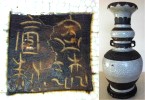
In this section we have tried to trace down the incised brown ground base marks on Chinese Porcelain. One would think there would have been at least one of those marks published in any book on Chinese porcelain book published around the 1870's until the end of the Qing dynasty but, so far I have failed to find one.
Exactly when this kind of marks first started to be used is actually not known. Traditionally the "Guangxu" period (1875-1908) is given as the starting point, and that assumption has been followed by us in suggesting dates for individual pieces here and on other places on this site.
When looking for reference pieces of porcelain it seems like the feature of adding brown etched sections or borders to the enamel decoration begins at the earliest during the Tongzhi 1862-74 period. From this period I have seen vases with enamels and broad bands of brown etched decoration in the shape of roof tiles, adding a three dimensional aspect to the decoration.
Somewhat later, and I feel pretty sure this is during the early Guangxu period, we get brown etched borders with quatrefoil/ruyi medallions inserted, and it is from this period I personally think we have the first brown etched marks. Some of them say Chenghua and a few seems to say Kangxi. The idea of falling back to these two periods were very much in vogue during the Empress Dowager's period from the 1860s to the first decade of the 20th century, which probably is the starting period of this mark.
Decorations with brown etched parts such as borders, bands, animal heads and raised dragons etc are still produced and any such object can also be perfectly modern. The square brown mark itself seems to be copying the appearance of Japanese Satsuma marks who are often drawn in gold within a brown medallion, which assumption also gives us another reference for the time frame to look for.
The only firm date I am so far certain about is on one piece confirmed as having been bought in the 1940's. I would be happy for any further information on some dated pieces or any archaeological data that supports any firm date at all on these pieces.
Jan-Erik Nilsson
This page has been created together with expert members of the Gotheborg Discussion Board.
| UNKNOWN MARKS / RECENT ADDITIONS | |
|---|---|
 |
191. Mark on crackled glaze porcelain bowl. Guangxu period/Late 19th Century. |
 |
1384. Unknown mark, on crackled Ge type glaze vase with etched brown application. The vase looks modern in my view and I would at least consider a second half 20th century Macao ware. |
The marks section of Gotheborg.com was initially established in May 2000 thanks to a generous donation of approximately one hundred images of Japanese porcelain marks, by Karl-Hans Schneider from Euskirchen, Germany. This contribution provided a modest yet substantial beginning of the Marks Section. It was a kind gesture that I really appreciated.
Of the many later contributors, I would especially want to mention Albert Becker, Somerset, UK, who was the first to help with some translations and comments on the Japanese marks. His work was then greatly extended by Ms. Gloria S. Garaventa, after which Mr. John Avery looked into and corrected some of the dates. Most of the Satsuma marks were originally submitted by Ms. Michaela Russell, Brisbane, Australia. A section which was then greatly extended by Ian & Mary Heriot, a large amount of information from which still awaits publication.
A warm thank you also goes to John R. Skeens, Florida, U.S.A., and Toru Yoshikawa for the Kitagawa Togei section, and to Susan Eades for her help and encouragement towards the creation of the Moriyama section. For the last full overhaul of the Satsuma and Kutani sections, thank you to Howard Reed, Australia. The most recent larger contribution was made by Lisa M. Surowiec, New Jersey, USA.
In 2004 and from then on, my warm thank you goes to John Wocher and Howard Reed, whose knowledge and interest have sparked new life into this section and given reason for a new overhaul. Thank you again and thank you to all I have not mentioned here, for all help and interest in and contributions to our knowledge of 20th-century Japanese porcelain.
The Chinese marks section would not have been possible without the dedicated help of Mr. Simon Ng, City University of Hong Kong, whose translations and personal efforts in researching the origin and dates of the different marks have been an invaluable resource. It has since been greatly extended by several contributors such as Cordelia Bay, USA, Walt Brygier, USA, Bonnie Hoffmann, Harmen Lensink, 'Tony' Yalin Zhang, Beijing, 'ScottLoar', Shanghai, Mike Harty, and many more expert members of the Gotheborg Discussion Board.
A number of reference pieces have also been donated by Simon Ng, N K Koh, Singapore, Hans Mueller, USA, Hans Slager, Belgium, William Turnbull, Canada, and Tony Jalin Zhang, Beijing.
All images and text submitted by visitors and published anywhere on this site are and remain the copyrighted property of the submitter and appears here by permission of the owners which can be revoked at any time. All information on this site, that are not specifically referenced to peer reviewed sources, are the personal opinions given in good faith by me, my friends and fellow experts, based on photos and the owners' submitted descriptions. They are not to be used for any financial or commercial decisions, but for educational and personal interest only, and can and will be changed as further information merits.
For further studies, Encyclopedia Britannica is to be recommended in preference to Wikipedia, which, not being peer-reviewed, might contain misleading information.
Web design and content as it appears here © Jan-Erik Nilsson 1996-.